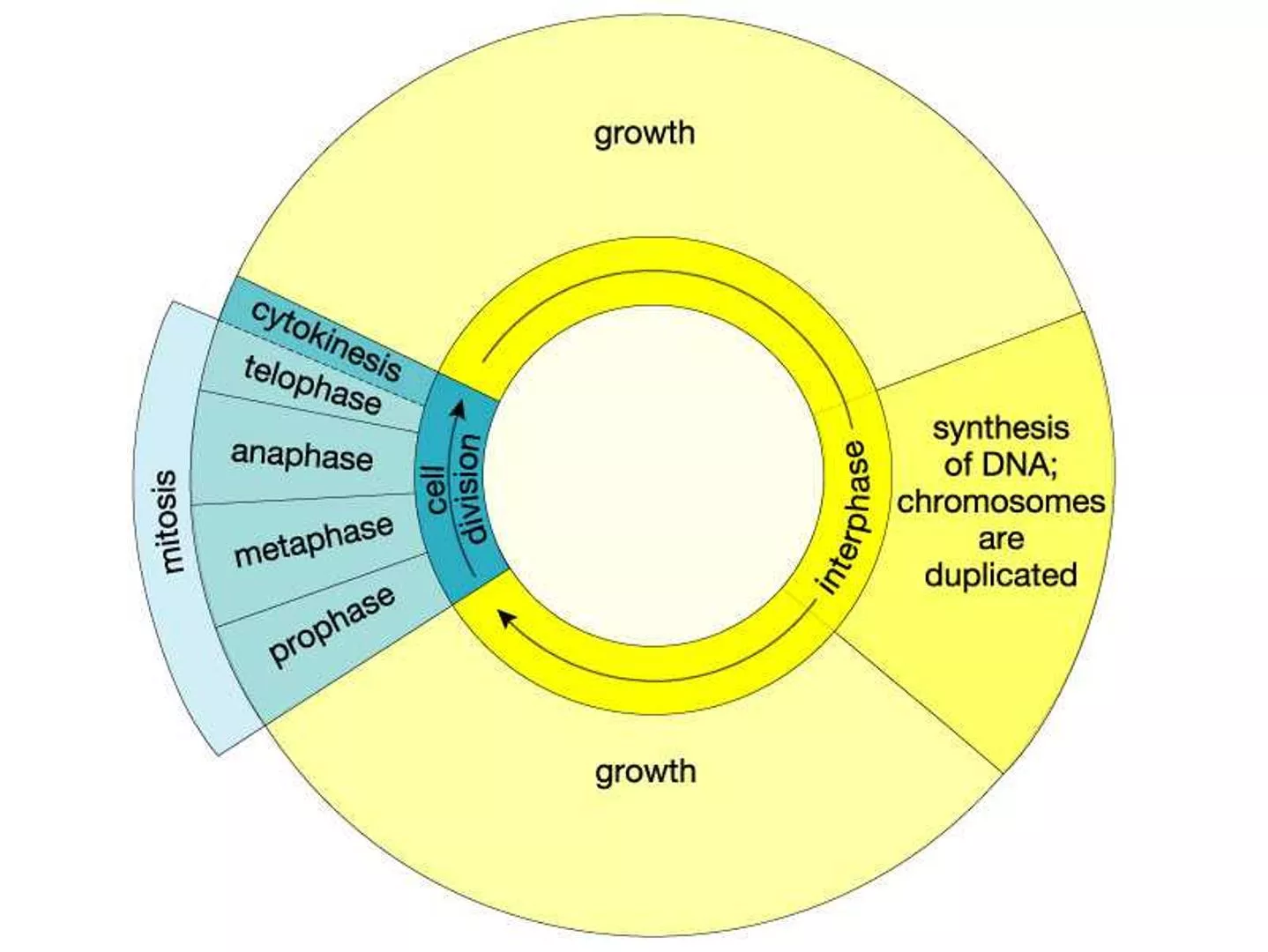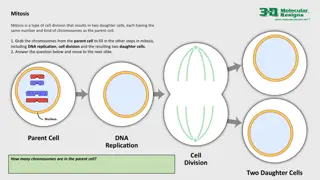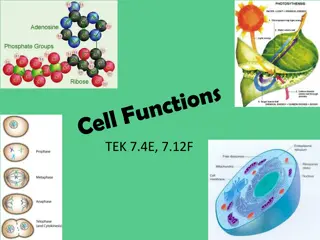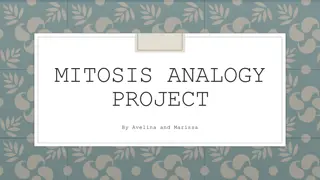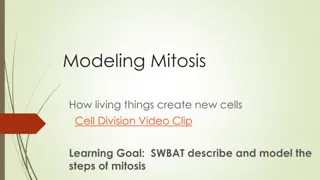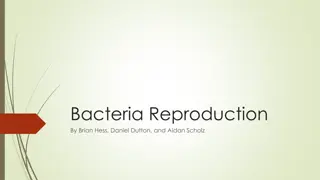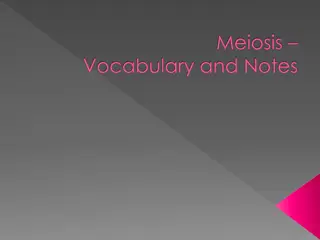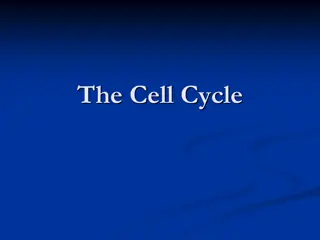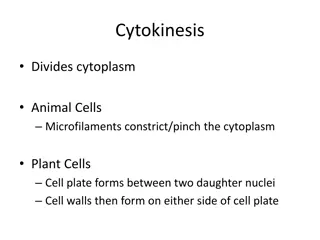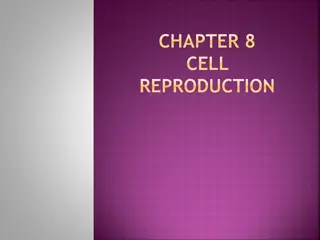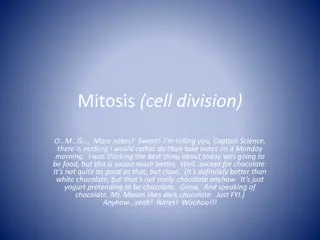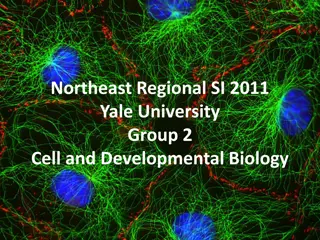Understanding the Cell Cycle and Mitosis Process
The cell cycle consists of two main periods: Interphase and Mitosis. During Interphase, the cell prepares for division by growing in size and copying chromosomes. Mitosis, the division of the nucleus, results in the formation of two daughter cells with identical chromosome copies. Centrioles and centromeres play crucial roles in chromosome movement and organization. Mitosis is essential for cell growth and development, while meiosis is specialized for reproductive cell formation. Chromosomes, consisting of coiled DNA, are key structures in cell division, tightly regulated during the process. Mitosis is a common cellular division process occurring throughout an organism's life.
Download Presentation

Please find below an Image/Link to download the presentation.
The content on the website is provided AS IS for your information and personal use only. It may not be sold, licensed, or shared on other websites without obtaining consent from the author. Download presentation by click this link. If you encounter any issues during the download, it is possible that the publisher has removed the file from their server.
E N D
Presentation Transcript
The Cell Cycle and Mitosis The cell cycle is a sequence of growth and division in a cell. It has 2 distinct periods: Interphase and Mitosis. 1. Period of growth is called Interphase. A cell increases in size. Chromosomes are copied to get ready for division. New organelles are synthesized for the new cell.
2. Period of Division is called Mitosis (Division of Nucleus) 2 daughter cells are formed with identical copies of chromosomes. 3.Period of Cellular Division called Cytokinesis.
Definitions 1. Chromatin Uncoiled DNA 2. Chromosomes Coiled DNA 3. Chromatid of a chromosome 4. Centromere Connects two chromatids together to make a chromosome 5. Centrioles Organelles used in cell division to move chromosomes to opposite side of the cell. 6. Mitosis - is normal cell division (makes body cells) 7. Meiosis - is the special cell division that creates the sperm and eggs 8. Daughter Cell(s) the new cells produced by Mitosis.
Cell Growth and Death Growth Mitosis: growth and development Meiosis: reproductive cells Death Apoptosis: programmed cell death
Mitosis Cells divide to make more cells. Chromosomes must be precisely divided so that each daughter cell gets exactly the same DNA. Mitosis is normal cell division, which goes on throughout life in all parts of the body. Meiosis is the special cell division that creates the sperm and eggs, the gametes. We will discuss meiosis separately.
Mitosis: development mitotic cell division mitotic cell division (a) (b) (c)
Chromosomes The DNA is supported and neatly packaged. DNA in the nucleus is uncoiled (chromatin), or tightly condensed into the X-shaped chromosomes we can see in the microscope. Each chromosome has a central constricted region called a centromere that serves as an attachment point for the machinery of mitosis. Centromere
Machinery of Mitosis The chromosomes are pulled apart by the spindle fibers, which is made of microtubules. The spindle fibers are attached to each centromere , and anchored on the other end to a centriole (which is the organizing center for the spindle).
Prophase 1. The chromatin condense making chromosomes, which makes them easier to pull apart. 2. The nuclear envelope and nucleolus disappears. 3. The centrioles move to opposite poles. 4. The microtubules form spindle fibers, growing out of the centrioles towards the chromosomes.
Metaphase Metaphase is a short resting period where the chromosomes are lined up on the equator of the cell, with the centrioles at opposite ends and the spindle fibers attached to the centromeres. Everything is aligned for the rest of the division process to occur.
Anaphase In anaphase, the centromeres divide. Spindle fibers are attached to the centromeres Then the spindle fibers contract, and the chromosomes are pulled to opposite poles, towards the centrioles.
Telophase In telophase the cell begins to divide. The chromosomes are at the poles. The spindle fibers disintegrates,The nuclear envelope and nucleolus re-forms The cytoplasm is divided into 2 separate cells, the process of cytokinesis.
Cytokinesis The organelles (other than the chromosomes) get divided up into the 2 daughter cells passively: they go with whichever cell they find themselves in. In animal cells, a ring of actin fibers (microfilaments are composed of actin) forms around the cell equator and contacts, pinching the cell in half.
Summary of Mitosis Prophase: Chromatin condenses into chromosomes Nuclear envelope and nucleolus disappears centrioles move to opposite sides of the cell Spindle fibers form and attaches to centromeres on the chromosomes Metaphase Chromosomes lined up on equator of cell centrioles at opposite ends of cell Anaphase Centromeres divide: each chromosome becomes two chromatids Chromosomes pulled to opposite poles by the spindle fibers Telophase Chromosomes de-condense Nuclear envelope and nucleolus reappears Spindle fibers disappear Cytokinesis: the cytoplasm is divided into 2 cells
(a) Interphase (b) Late prophase (c) Metaphase (f) interphase (e) Telophase (d) Anaphase
The Cell Cycle and Cancer Learn the importance of the cell cycle and a real life example when it is not controlled: cancer. Music used with permission from Adrian Holovaty (http://www.youtube.com/c/adrianholovaty). Support us on Patreon! http://www.patreon.com/amoebasisters Our FREE resources: GIFs: http://www.amoebasisters.com/gifs.html Handouts: http://www.amoebasisters.com/handouts.html Comics: http://www.amoebasisters.com/parameciumparlorcomics Connect with us! Website: http://www.AmoebaSisters.com Twitter: http://www.twitter.com/AmoebaSisters Facebook: http://www.facebook.com/AmoebaSisters Tumblr: http://www.amoebasisters.tumblr.com Pinterest: http://www.pinterest.com/AmoebaSister-s Instagram: https://www.instagram.com/amoebasistersofficial/ Visit our Redbubble store at http://www.amoebasisters.com/store.html The Amoeba Sisters videos demystify science with humor and relevance. The videos center on Pinky's certification and experience in teaching science at the high school level. Pinky's teacher certification is in grades 4-8 science and 8-12 composite science (encompassing biology, chemistry, and physics). Amoeba Sisters videos only cover concepts that Pinky is certified to teach, and they focus on her specialty: secondary life science. For more information about The Amoeba Sisters, visit: http://www.amoebasisters.com/about-us.html We cover the basics in biology concepts at the secondary level. If you are looking to discover more about biology and go into depth beyond these basics, our recommended reference is the FREE, peer reviewed, open source OpenStax biology textbook: https://openstax.org/details/books/biology We take pride in our AWESOME community, and we welcome feedback and discussion. However, please remember that this is an education channel. See YouTube's community guidelines https://www.youtube.com/yt/policyandsafety/communityguidelines.html and YouTube's policy center https://support.google.com/youtube/topic/2676378?hl=enref_topic=6151248. We also reserve the right to remove comments with vulgar language. We have YouTube's community contributed subtitles feature on to allow translations for different languages. YouTube automatically credits the different language contributors below (unless the contributor had opted out of being credited). We are thankful for those that contribute different languages. If you have a concern about community contributed contributions, please contact us. Control of the Cell Cycle - Normal Control of the Cell Cycle Controlled by enzymes and proteins which are controlled by the environment. Uncontrolled division can result in cancer.
Cancer: A mistake in the Cell Cycle Results of mistakes in one or more genes that produce substances involved in controlling the enzymes of the cell cycle (cyclins). This can lead to the formation of masses of cells (tumors) Can enter the circulatory system and spread throughout the body (metastasis). 2ndleading cause of death in U.S. after heart disease.
Causes of Cancer Genetic passed on from parent to offspring. Environmental different cancers are more prevalent in different areas. Cigarette smoke, air/water pollution, UV radiation, and chemicals are called carcinogens or mutagens.
Cancer Prevention Diets low in fats and high in fiber can reduce the risks of many kinds of cancer. Why? Vaccines and sunscreen may also help prevent cancer. Daily exercise and not using alcohol, drugs, or cigarettes also reduce the risk of cancer.


